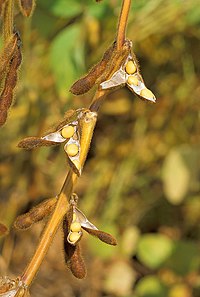
Photo from wikipedia
Algae are natural sources of nutrients, but the presence of anti-nutritional factors often compromises nutrient apparent digestibility coefficients (ADCs) in several fish species. In this study, physical-mechanical and enzymatic technological… Click to show full abstract
Algae are natural sources of nutrients, but the presence of anti-nutritional factors often compromises nutrient apparent digestibility coefficients (ADCs) in several fish species. In this study, physical-mechanical and enzymatic technological processing was applied to two seaweeds (Gracilaria gracilis and Ulva rigida) and three microalgae (Nannochloropsis oceanica, Chlorella vulgaris, and Tetraselmis sp.) in order to evaluate its effectiveness in improving nutrient ADC values in diets for European seabass. A practical commercial-based diet was used as reference (REF) and experimental diets were prepared by replacing 30% of REF diet with each test alga used either intact or after processing. Sodium dodecyl sulfate-polyacrylamide gel electrophoresis (SDS-PAGE) and fast performance liquid chromatography (FPLC) analyses revealed that enzymatic processing was more effective than the physical one in changing the protein and peptides composition, increasing the amount of low-molecular-weight compounds in seaweeds and N. oceanica microalgae. Protein digestibility was significantly affected by algae species and in the case of the microalgae by the technological process. Gracilaria gracilis is better digested than U. rigida and physical processing enhanced protein and energy ADC values. Nannochloropsis oceanica and C. vulgaris are better digested than Tetraselmis sp.; the highest protein and energy ADCs were observed in diets containing enzymatically processed N. oceanica (NAN-ENZ) and physically processed C. vulgaris (CHLO-PHY), followed by the diet with physically processed Tetraselmis sp. (TETR-PHY). Results clearly showed that it is possible to increase nutrient accessibility and digestibility of algae by fish, by selecting the most adequate method to disrupt the cell wall. Moreover, the physical-mechanical and enzymatic technological processes used in this study are scalable to the industrial level.
Journal Title: Journal of Applied Phycology
Year Published: 2020
Link to full text (if available)
Share on Social Media: Sign Up to like & get
recommendations!